|
|
Recent Progress on Materials for Hydrogen Generation via Hydrolysis
DENG Jifeng, CHEN Shunpeng, WU Xiaojuan, ZHENG Jie, LI Xingguo
2021 Vol. 36 (1): 1–8
 Abstract
Abstract(
1704 )
 HTML
HTML(
83)
 PDF
PDF(3364KB)(
2083
)
Hydrolysis is a unique method for hydrogen generation at ambient condition. Widespread attentions have been paid to materials for hydrogen generation via hydrolysis due to several advantages: high theoretical hydrogen capacity, moderate storage and operation condition, safety, etc. In this paper, recent progress and development in this area were reviewed. Three types of materials including borohydride (NaBH4, NH3·BH3), metal (Mg, Al), and metal hydride (MgH2) were introduced. Several issues about them were discussed specifically: mechanism, main problems, designments of catalysts and materials, etc. Based on these discussions, we compared the different materials mentioned above, commented their current performances and practical difficulties. At last, prospects in this field were presented.
|
|
|
Porous Carbon Nanomaterials Based Tumor Targeting Drug Delivery System: a Review
CHENG Xiaokun, ZHANG Yue, Lü Haijun, LIU Xinying, HOU Senlin, CHEN Aibing
2021 Vol. 36 (1): 9–24
 Abstract
Abstract(
1144 )
 HTML
HTML(
87)
 PDF
PDF(8933KB)(
1678
)
Chemotherapy is the main method used for cancer treatment. However, most chemotherapeutic drugs show low selectivity towards tumor cells. When killing tumor cells, chemotherapeutic drugs can also damage normal tissue cells and induce a series of side effects and toxic reactions, such as gastrointestinal reactions, calvities and so on. An effective way to reduce the adverse drug reactions is to construct targeted delivery systems based on the microenvironment properties of tumor tissue. Porous carbon nanomaterials (PCN), with excellent properties such as good structural stability, pores, and easily modified surface, are promising candidate to be used for such strategy. In this paper, the construction and application of the PCN-based targeted antitumor drugs delivery system were reviewed; the structural properties, the design philosophy of PCN suitable for drug loading were summarized; the effective strategies to improve drug loading on PCN for combined drug delivery were discussed both theoretically and experimentally. The mechanism and applications of PCN for tumor microenvironment based targeted delivery system were analyzed from the perspectives of endogenous sensitive stimulations (such as acidity, redox potential and specific enzyme), exogenous sensitive stimulations (such as light and magnetic) and multiple sensitive stimulations (such as double sensitive stimulations, including acidity/redox potential, acidity/magnetic and magnetic/light, and three sensitive stimulation, including acidity/redox potential/light). The biocompatibility and biodegradability of PCN used as anti-tumor drug delivery system was discussed, and the possible solutions were analyzed. The prospects of the application of PCN to be used in tumor drugs were discussed at the end of this review. This review provides theoretical basis and examples towards design and synthesis of porous carbon (PC) materials based anti-tumor drug delivery system, which may help the research and development of targeted and controllable tumor treatment.
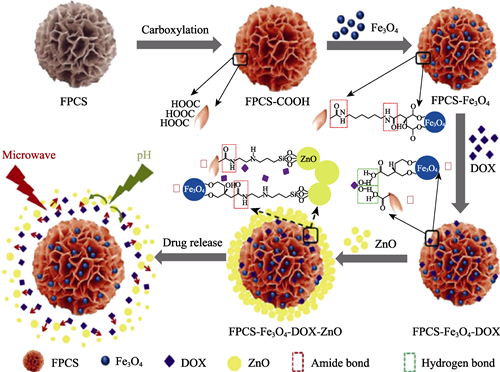
|
|
|
Radionuclides from Nature to Nature: Recent Progress in Immobilization of High Level Nuclear Wastes in SYNROC
DUAN Tao, DING Yi, LUO Shilin, ZHANG Shengtai, LIU Jian
2021 Vol. 36 (1): 25–35
 Abstract
Abstract(
534 )
 HTML
HTML(
17)
 PDF
PDF(1889KB)(
1170
)
The production of nuclear energy, the development of nuclear energy, and the development of nuclear weapons inevitably produce radioactive waste among which the existing high-level radioactive waste is one of the most difficult to deal with. With the implementation of “actively developing nuclear power” strategy in China, the safe and effective disposal of radioactive waste has become a key issue in addressing the sustainable development of nuclear power. SYNROC solidification is considered as the ideal medium material for the second generation of solidified high-level radioactive waste. Based on the review of the concept of synroc solidification and the classification of candidate mineral host, we mainly introduce the latest research progress in the rapid synthesis method of SYNROC, the nucleation mechanism, and the long-term stability evaluation, in the path that though the road is hindered and long, the line is approaching if striving forward. Finally, the existing weakness of SYNROC curing is pointed out, and the research direction and development trend that should be paid attention to in the future are proposed.
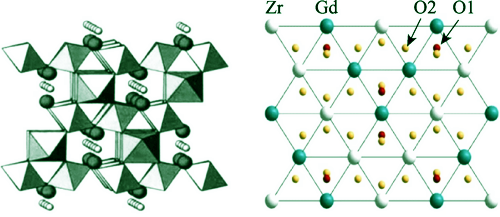
|
|
|
Synthesis and Characterization of SiC@SiO2/BN/PI Composites by in-situ Polymerization
GAO Jiming, YANG Yang, LEI Ting, WANG Jin, LIU Jie, ZHANG Limin
2021 Vol. 36 (1): 36–42
 Abstract
Abstract(
643 )
 HTML
HTML(
15)
 PDF
PDF(1132KB)(
1078
)
Polyimide composites have attracted more and more attention due to their excellent properties and wide application prospects in aerospace, rail transit, microelectronics and other fields. SiC@SiO2 whisker was prepared by oxidation of SiC whisker at 750 ℃, which formed mixed fillers with BN particles. The SiC@SiO2 whisker and BN were modified by a silane coupling agent and a titanate coupling agent, respectively. SiC@SiO2/BN/PI composites were prepared by in-situ polymerization. The structure and property of the fillers and composites were characterized. Whiskers and particles formed an effective pathway in the polyimide matrix, which promoted continuous improvement of the thermal conductivity of SiC@SiO2/BN/PI composites. When the total filler content was 45wt% and the mass ratio of whiskers to particles was 4 : 1, the thermal conductivity was increased to 0.95 W/(m·K). Mechanical properties of SiC@SiO2/BN/PI composites changed regularly with the type and amount of mixed fillers. The SiO2 layer blocks the communication of free electrons between the mixed fillers, and the decreasing range of electrical insulation performance of the SiC@SiO2/BN/PI composites declined.
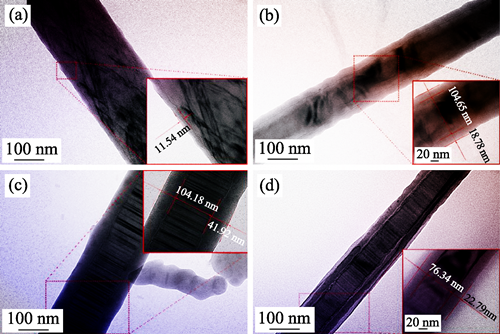
|
|
|
Magnetic and Dielectric Properties of Ti 4+-doped M-type Hexaferrite BaFe12-xTixO19 Ceramics
BAI Jiawei, YANG Jing, LÜ Zhenfei, TANG Xiaodong
2021 Vol. 36 (1): 43–48
 Abstract
Abstract(
541 )
 HTML
HTML(
8)
 PDF
PDF(685KB)(
836
)
Hexaferrite system is expected to be applied in various kinds of multi-state memories, magnetoelectric sensors and other new microelectronic devices, due to its high temperature magnetoelectric coupling effect with low field. Not only the B-site doping of M-type hexaferrite BaFe12O19 with Ti 4+ ion can change its magnetic structure and magnetic properties, but also the defects, multivalent Fe ions, introduced by B-site non-epuivalent Ti doping, could affect its electric properties. In this study, M-type hexaferrite BaFe12-xTixO19 (x=0, 0.5, 1, 1.5) ceramics were prepared by solid phase sintering. The effects of Ti 4+ doping on the structural, magnetic and dielectric properties were studied. The results show that BaFe12-xTixO19 is in ferrimagnetic order with antiparallel spins. When the doping concentration of Ti 4+ ions is low, it tends to replace Fe 3+ ions with up-spin. And the magnetization decreases with the increase of Ti dopant. However, with the further increase of Ti 4+ doping, Fe 3+ ions with down-spin is also replaced, and the saturation magnetization increases with the increase of x. The introduction of Ti 4+ ions can also make the grains to be semiconductor, which results in the Maxwell-Wagner interface polarization behavior at the interfaces between semiconducting grains and grain-boundaries. Hence, M-type hexaferrite BaFe12-xTixO19 ceramics appear obvious low frequency dielectric enhancement accompanied by a Maxwell-Wagner dielectric relaxation.
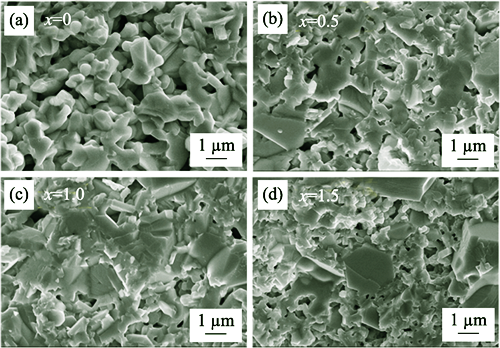
|
|
|
Molten Salt Assisted Synthesis of Dy3Si2C2 Coated SiC Powders and Sintering Behavior of SiC Ceramics
WAN Peng, LI Mian, HUANG Qing
2021 Vol. 36 (1): 49–54
 Abstract
Abstract(
716 )
 HTML
HTML(
32)
 PDF
PDF(3962KB)(
1074
)
Silicon carbide is widely used because of its excellent physical and chemical properties. The chemical bonding characteristics of SiC make it difficult to be sintered. Therefore, preparation of high-quality SiC ceramics is one of the challenges in SiC research field. In this study, the ternary rare-earth carbide Dy3Si2C2 was proposed as a new sintering additive for SiC ceramics, through the phase transition of Dy-Si-C system at high temperatures to promote the densification of SiC. The Dy3Si2C2 coated SiC powders were synthesized via an in-situ reaction between metal Dy and SiC in high temperature molten salts. The Dy3Si2C2 coated SiC powder was sintered by spark plasma sintering (SPS), at 1800 ℃, 45 MPa. As the result, high-purity SiC ceramic with the density of 99% and thermal conductivity of 162.8 W·m -1·K -1was obtained to form the SiC-Dy3Si2C2 raw material with n(Dy) : n(SiC)=1 : 4. Further study shows that Dy3Si2C2 and SiC undergo a eutectic reaction at high temperatures, which generates liquid phase at the grain boundaries and promotes the densification of SiC ceramics. This study shows that the ternary rare-earth carbides Re3Si2C2 (Re=La, Ce…) has great potential to be used as the sintering additive for SiC.
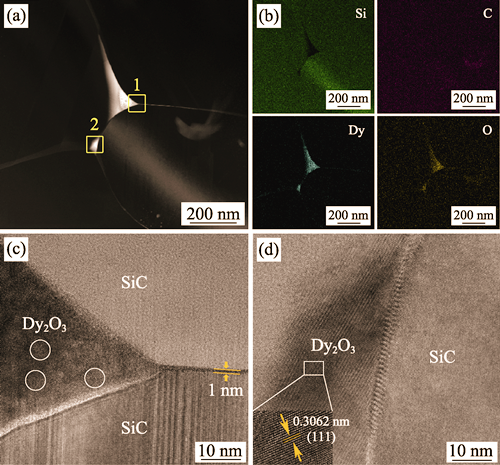
|
|
|
Interface Type on the Static Mechanical Properties and Internal Friction of 3D-SiC/SiC Composites
MA Denghao, HOU Zhenhua, LI Junping, SUN Xin, JIN Enze, YIN Jian
2021 Vol. 36 (1): 55–60
 Abstract
Abstract(
568 )
 HTML
HTML(
16)
 PDF
PDF(1376KB)(
984
)
Microstructure and static mechanical properties of 3D-SiC/SiC composites with different interfaces, such as PyC, SiC and PyC/SiC and without an interface were prepared via polymer infiltration and pyrolysis, and effect of interface type on the internal friction was investigted by means of forced vibration. The results showed that the microstructure and static mechanical properties of SiC/SiC composites with an interphase layer were superior to the composites without an interlayer, and the former also showed a lower internal friction than the later. The sub-layer SiC of the PyC/SiC interface limits the binding state and the plastic deformation of PyC interphase, beneficial to improving the mechanical properties of SiC/SiC composite. Meanwhile, The interface layer of SiC/SiC composites has a significant effect on the internal friction behavior, with interfacial shear strength inversely proportional to the internal friction. By comparing the change rate of internal friction of composites at 50 and 350 ℃, the overall trend of internal friction decreases with the increase of interfacial shear strength. In addition, as compared with the composite with PyC interface, the composite with PyC/SiC interface has a lower change rate of the internal fiction, indicating that PyC/SiC interface of SiC/SiC composites is more helpful for high temperature vibration environment.
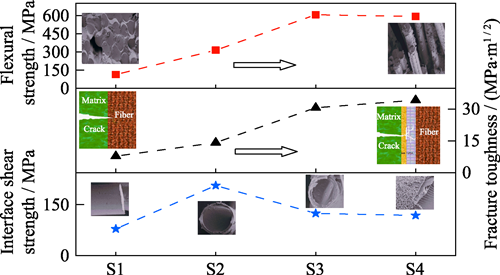
|
|
|
Research on Machine Learning Based Model for Predicting the Impact Status of Laminated Glass
MENG Yanran, WANG Xinger, YANG Jian, XU Han, YUE Feng
2021 Vol. 36 (1): 61–68
 Abstract
Abstract(
548 )
 HTML
HTML(
9)
 PDF
PDF(972KB)(
891
)
Architectural laminated glass exhibits significant vulnerability under hard body impacts such as windborne debris impacts. In this work, a prediction model is proposed for assessing the impact status of laminated glass under hard body impact. Multiple design variables including the glass make-ups, interlayer types, support conditions and size are considered. The impact tests with consecutive impact attempts are first conducted. A comprehensive database encompassing the failure condition of each glass layer is then established. This database has 567 groups of PVB laminated glass data and 210 groups of SGP laminated glass data. A combined WOA-KELM machining learning based model is subsequently developed to predict the impact status of laminated glass. The modelling results are compared with that from SVM and LSSVM based models. The results show that the proposed model has a prediction accuracy of 88.45% in failure status of each glass layer. Such model can well predict the impact status of laminated glass and shows better performance in both accuracy and computation cost than other models.
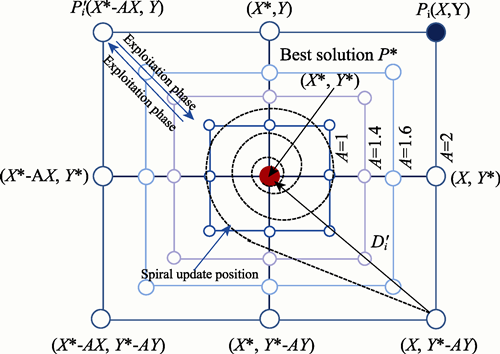
|
|
|
Efficient Preparation of CuGeO3 with Controllable Morphology Using CuCl2 as Copper Source
XIAO Yumin, Li Bin, QIN Lizhao, LIN Hua, LI Qing, LIAO Bin
2021 Vol. 36 (1): 69–74
 Abstract
Abstract(
333 )
 HTML
HTML(
5)
 PDF
PDF(1633KB)(
555
)
Copper germanate has attracted wide attention because of its spin-Peierls transition and excellent lithium storage performance. Typical hydrothermal method uses weak acid salts such as Cu(CH3COO)2 to promote the ionization of water to obtain OH - required for the growth of CuGeO3. Although the operation is facile, the reaction time is long and the efficiency is low. In this work, CuCl2 was used as the copper source instead of Cu(CH3COO)2 and the pH of precursor solution was adjusted to control the adsorption capacity of each crystal plane and the supersaturation of the solution, so as to achieve efficient preparation of CuGeO3 nanorods and CuGeO3 hexagonal nanosheets, effectively shortening the reaction time to 8 h. Based on this, one-dimensional structure-directing agent ethylenediamine was added to accelerate the reaction process while limiting the two-dimensional planar growth of CuGeO3, and six different sizes ( 100 nm, 200-300 nm, 350-500 nm, 400-700 nm, 1-2 μm and 1-3 μm) of uniform CuGeO3 nanowires were efficiently prepared.
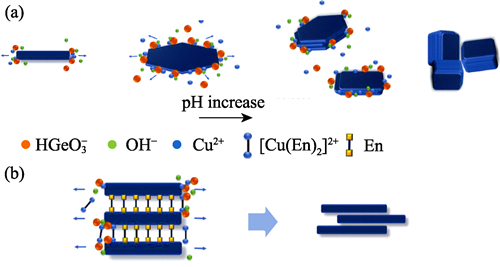
|
|
|
Structures and Thermoelectric Properties of (GeTe)nBi2Te3
YANG Xiao, SU Xianli, YAN Yonggao, TANG Xinfeng
2021 Vol. 36 (1): 75–80
 Abstract
Abstract(
790 )
 HTML
HTML(
18)
 PDF
PDF(2899KB)(
1098
)
In general, (GeTe)n(Bi2Te3)m compounds in GeTe-Bi2Te3 pseudo-binary system possess a relatively low thermal conductivity, however, the thermoelectric properties of these compounds have not been evaluated systematically. In this study, a series of single-phase (GeTe)nBi2Te3 (n=10, 11, 12, 13, 14) compounds were prepared by a melting-quenching-annealing process combined with spark plasma sintering. The phase compositions and thermoelectrical properties of these samples were characterized. It is found that doping with Bi2Te3 intensifies the phonon scattering and significantly reduces the lattice thermal conductivities of these samples, producing a low total thermal conductivity of 1.63 W?m -1?K -1 at 723 K for (GeTe)13Bi2Te3 compound. Moreover, the effective mass of these compounds is enhanced through adjustment of the relative amount of Bi2Te3 and GeTe. Therefore, the Seebeck coefficient and power factor of these samples remain superior even at high carrier concentration. At 723 K, the maximum power factor of (GeTe)13Bi2Te3 compound is 2.88×10 -3 W?m -1?K -2 and the maximum ZT of (GeTe)13Bi2Te3 is 1.27, which is 16% higher than that of pristine GeTe.
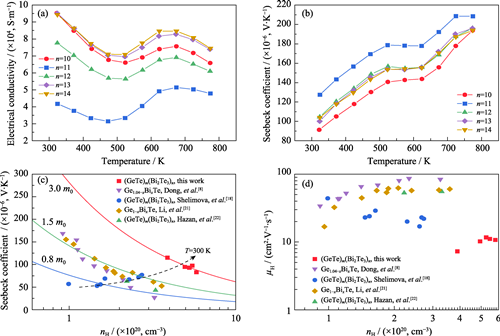
|
|
|
Photothermal/pH Responsive B-CuS-DOX Nanodrug for Chemo-photothermal Synergistic Therapy of Tumor
XIE Xue, WU Jianrong, CAI Xiaojun, HAO Junnian, ZHENG Yuanyi
2021 Vol. 36 (1): 81–87
 Abstract
Abstract(
703 )
 HTML
HTML(
21)
 PDF
PDF(7502KB)(
1040
)
Nanoparticles-based drug delivery system for synergetic chemo-photothermal therapy is an efficient strategy for tumor therapy. However, construction of nanodrugs with high drug loading capacity and good photothermal conversion property is still a great challenge. In this work, two-dimensional boron nanosheets were prepared by ultrasonic liquid exfoliation method, which were further loaded with ultra-small copper sulfide (CuS) nanoparticles and doxorubicin (DOX) to obtain B-CuS-DOX nanocomposites. The prepared B-CuS-DOX exhibited high drug loading capacity (864 mg/g) and excellent photothermal conversion efficiency (55.8%). In addition, B-CuS-DOX exhibited pH and laser--responsive drug release behavior. In vitro results demonstrated that the prepared B-CuS-DOX achieved a good synergistic effect of chemotherapy and photothermal therapy. This work is expected to provide an effective chemo-photothermal synergistic therapy strategy for tumor therapy.
|
|
|
Bi-doped Ceria with Increased Oxygen Vacancy for Enhanced CO2 Photoreduction Performance
LIU Yaxin, WANG Min, SHEN Meng, WANG Qiang, ZHANG Lingxia
2021 Vol. 36 (1): 88–94
 Abstract
Abstract(
1084 )
 HTML
HTML(
61)
 PDF
PDF(1109KB)(
1447
)
Oxygen vacancy plays an important role in promoting CO2 adsorption and reduction on photocatalysts. Bi was heavily doped into ceria, forming a solid solution catalyst Ce1-xBixO2-δ meanwhile maintaining the fluorite structure, to increase the oxygen vacancy concentration. The sample Ce0.6Bi0.4O2-δ showed the highest photocatalytic activity with a CO yield of ~4.6 times that of the pristine ceria nanorods. Bi was homogeneously dispersed into the fluorite ceria which was confirmed by XRD and EDX elemental mapping. It has been evidenced by the results of Raman and XPS that Bi introduction boosts the concentration of oxygen vacancy in the solid solution that can facilitate the adsorption/activation of carbonate and bicarbonate intermediates on its surface according to in-situ FT-IR.
|
|
|
Electron Irradiation Induced Phase-separation Behavior in AlF3 Doped Alumina Ceramic with Superior Sensitivity
SHEN Lu, WANG Dewen, HUANG Rong, DU Shiyu, HUANG Qing
2021 Vol. 36 (1): 95–100
 Abstract
Abstract(
500 )
 HTML
HTML(
12)
 PDF
PDF(1272KB)(
879
)
An electron irradiation induced fast phase-separation behavior was observed under convention Transmission electron microscopy (TEM) observation of spark plasma sintered AlF3 doped alumina ceramic. Spherical nanocrystalline Al precipitates separated out from original alumina grain surface within several seconds under transmission electron microscopy electron irradiation. By high resolution TEM observation combined with diffraction patterns analysis, it was found that the original alumina grain surface was in highly defected state. After electron irradiation under TEM, the defects on original alumina surface vanished accompanied by the precipitation of nanocrystalline Al particles. By thoroughly analysis of the defect reaction during doping process and the feature of cation sub-lattice of alumina, a defect assisted interstitial atom segregation mechanism was proposed to explain this behavior. According to this mechanism, doped F ions first occupied oxygen vacancy sites with corresponding Al ions at intrinsic interstitial sites. After oxygen vacancies being fully occupied, both F and Al ions tended to settle down at intrinsic octahedron interstitial sites, which resulted in a metastable doping state. Under the act of 1/3 [11ˉ00] partial dislocation of alumina matrix, distorted cation sub-lattice generated double aggregated vacant octahedron sites. When these doublets vacant octahedron sites were occupied by foreign Al ions, stacking faults composed of about three sequences were generated as that observed in high resolution TEM. Meanwhile, the segregated doping Al ions at double aggregated octahedron sites along the stacking faults worked as early stage precipitations. Under electron irradiation, with the ablation of F ions, the unstable segregated Al ions separated out as nano precipitation with the reconstruction of alumina lattice.
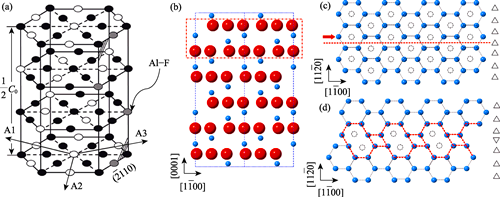
|
|
|
Modulation of SAPO-34 Property with Activated Seeds and Its Enhanced Lifetime in Methanol to Olefins Reaction
ZHANG Dongqiang, LU Huihui, SU Na, LI Guixian, JI Dong, ZHAO Xinhong
2021 Vol. 36 (1): 101–106
 Abstract
Abstract(
397 )
 HTML
HTML(
11)
 PDF
PDF(1780KB)(
874
)
Solvent-free synthesis of zeolites has received extensive attention in recent years, because it is advantageous over conventional hydrothermal synthesis. Nevertheless, SAPO-34, a micropore zeolite, prepared by this method does not satisfy the catalytic lifetime requirements of the methanol-to-olefins (MTO) reaction. Herein, an improved solvent-free approach was developed to synthesize SAPO-34 catalysts with enhanced MTO reaction performance, in which acid-etched seed crystals were introduced to modulate the physico-chemical properties of the zeolite via crystallization kinetics regulation. The results indicated that the SAPO-34 samples prepared from seed-containing precursor gels show considerably higher crystallinity, larger surface area, but lower strong acid site density than the parent sample. In particular, the catalytic lifetime of the SAPO-34 catalyst prepared from activated seeds was remarkably prolonged to 480 min, which was significantly superior to that of the parent sample (40 min). The result confirmed the validity of the seeding approach for modifying the zeolite properties via the solvent-free synthesis and the potential of the approach in improving catalytic performance.
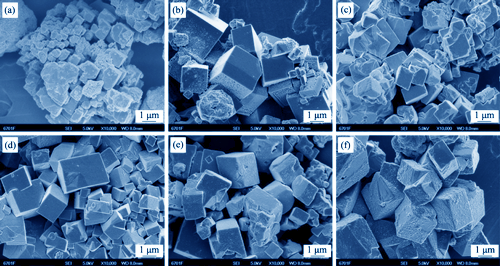
|
|
|
Nanocomposite “Xuan Paper” Made from Ultralong Hydroxyapatite Nanowires and Cellulose Fibers and Its Anti-mildew Properties
SHAO Yueting, ZHU Yingjie, DONG Liying, CAI Anyong
2021 Vol. 36 (1): 107–112
 Abstract
Abstract(
703 )
 HTML
HTML(
22)
 PDF
PDF(7461KB)(
1022
)
Xuan paper is an indispensable carrier for Chinese calligraphy and painting works. It has won the reputation of “the King of Paper” because of its superior durability and anti-mildew performance. Xuan paper was inscribed on the Representative List of the Intangible Cultural Heritage of Humanity by the Educational, Scientific and Cultural Organization of the United Nations in 2009. In this study, we developed a new type of nanocomposite “Xuan paper” made from ultralong hydroxyapatite nanowires and cellulose fibers with excellent anti-mildew performance. The whiteness of the as-prepared nanocomposite “Xuan paper” with HAP weight ratio of 25% is 76.1%, which is higher than that of the commercial unprocessed Xuan paper (71.9%) or the commercial processed Xuan paper (70.3%). The nanocomposite “Xuan paper” has superior performance in inhibiting the growth of three kinds of moulds (Chaetomium globosum, Trichoderma viride (long branch) and Aspergillus niger) compared with the blank control and commercial Xuan paper. During the incubation process, the mildew grows on the surface of the traditional Xuan paper, however, no obvious growth of mildew is observed on the surface of the nanocomposite “Xuan paper”. It is expected that the nanocomposite “Xuan paper” is favorable for its long-term safe preservation and application in calligraphy and painting arts.
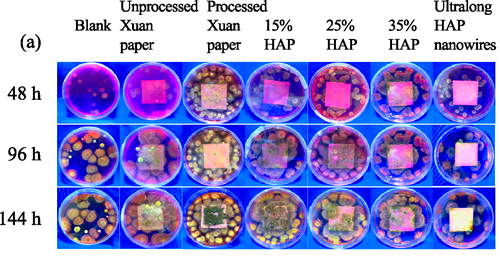
|
|